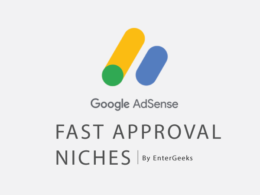A blog is a web portal, or a personal journal that is available on the World Wide Web. Blogs are usually maintained by an individual with regular entries of commentary, descriptions of events, or other material such as graphics or video. Entries are commonly displayed in reverse-chronological order, with most recent entries appearing first. Blog can also be used as a verb, meaning to maintain or add content to a blog.
1. Select Blog Topic or Niche
The very first step is to select the name and topic for your blog. The name of your blog is what the readers first notice (like yourdomainname.com) It should therefore reflect the broad subjects you’ll write about, or the name could represent your personal name, or the name of your company or a clever mix of words, or any other.
The blog’s niche is the broad topic which you’ll focus your posts on. Topics for blogs include food, travel fashion lifestyle, technology and more.
The good news is that there’s almost a community for any subject you’re interested in. However, there are certain topics that be more successful than other topics. You must choose an area that is appealing to a large audience, while still captivating to you.
- Potential: Is there something that you are naturally gifted at? Perhaps it’s a sport, game or even a musical instrument.
- Know-how: What skills and know-how have you acquired through the years? Perhaps you have something you learned in your schooling and you’re able to write about today. You can think of academic subjects or abilities such as car repair and languages.
2. Get your domain and hosting
a. Domain Name:
Domain names are the only address for a web site. It usually consists of a domain name and an extension of the domain name. A domain name that is memorable will enhance your brand and aid in helping people find your site.
Most of the web hosting provide offer free domain name registration on their web hosting plan. You can also register cheapest domain name yourself.
We strongly recommend using an .com domain. There are plenty of new extension of domain names on the market currently, from the traditional .com, .net and .org to niche extensions such as .host, .photography, .biz and even .blog.
While it’s tempting to think of creative blog names with the latest extensions available, .com is still the most trusted and well-established domain name extension. Our opinion is that newer domain extensions such as .host, .photography, .biz and others could make your company look less credible.
b. Web Hosting:
Hosting your website can be described as an internet-based service which makes your site’s content available on the internet. When you sign up for hosting that you rent space on a server physical to save all your site’s files and information.
How to choose web hosting?
There are a lot of different web hosting options out there and it can be hard to know which one is right for you. Here are a few things to consider when choosing a web host:
- Do you need a lot of storage space or bandwidth?
- Do you need a lot of features or are you happy with a basic package?
- How much support do you need?
- How much do you want to pay?
Once you’ve considered all of these factors, you can start looking at different web hosting providers and comparing their offerings. Be sure to read reviews from other customers before making your final decision.
Let me list out few best and cheap hosting packages to start your blog.
| Pricing Monthly | Disk SSD | Bandwidth Visits | Hosting Brand | Register Link |
|---|---|---|---|---|
| $1.99 USD | 50 GB | 10K Visits | Hostinger | Get Now |
| $1.45 USD | 10 GB | 50k Visits | Namecheap | Get Now |
| $2.95 USD | 10 GB | N/A | Bluehost | Get Now |
| $2.75 USD | Unlimited | Unlimited | Hostgator | Get Now |
| $3.75 USD | Unlimietd | Scalable | Domain.com | Get Now |
c. Connect Domain and Hosting (Configuration)
Let’s suppose that you’ve recently register a new domain name and does not access visitors to your site. The next step that you need to do connect (configure) Domain name with Hosting. There are many different options available to connect domain name with web hosting. But the primary and simple method is just point nameserver of hosting to the domain name.
3. Install CMS Free (WordPress)
WordPress is a popular content management system (CMS) that enables users to create and manage websites. WordPress is prone to security vulnerabilities, which can allow unauthorized access to your website data, including your personal user data, passwords, and credit card information. There are a number of ways to protect your WordPress website from unauthorized access, and we recommend you use a security plugin to help protect your site.
- Install WordPress
- Install a theme and customize designs
- Install most useful plugins
- Setup main pages
- Start writing article related to your niche
a. Install WordPress
We’ve finished the essential setup process of beginning your blog, it’s now time to have more enjoyment. The process of creating Your WordPress blog is the time when you may get a little tense in this process, however (if you’ve never had the opportunity to work on blogs before) However, I’ll assure you it won’t get too technical.
b. Install Theme and Customize Designs
If you’re just beginning to the idea of starting a blog, I would not suggest purchasing a premium WordPress theme as soon as you start. When you’ve seen some traffic and you can justify the expense It’s a good idea to select a premium theme that has more options and features. At the moment the complexity of a blog theme could distract from the primary goal of bringing people to your blog.
Best Free Themes for your Blog:
- Astra
- Generatepress
- Hello (Elementor Official)
- Neve
- Shapebox (By Alx.media)
A well-designed blog builds trust: It tells people that you are serious about your blog that you have made it look attractive. It doesn’t mean that you have to use excessive animations or lots of colors and fonts. In reality, the most effective designs are clean, simple and simple to understand.
c. Install most useful plugins
WordPress plugins play a vital aspect of how your blog functions and getting the best plugins in place as fast as you can is an important action that is designed to benefit your readers and work properly with search engines.
- YoastSEO – Free Search Engine Optimization Plugin
- Wordfence or, Itheme Security – For Security, malware scan etc…
- Site Kit by Google – Easily connect Google Search Console and Google Analytics
- WP Fastest Cache (Only if server does not offer “Litespeed Cache”)
- WpForms or Contact form 7 – To create contact form
- Smush Optimization – Image optimization and lazy load
- Elementor Page Builder (Optional) – Only if you wish to build designs from scratch
d. Setup Main Pages
As soon as you begin the blog, you’ll be looking to present some basic details about your self. What are you. Why people should pay attention to your voice. How can they contact you in case they have any concerns or would like to collaborate with you.
The pages here are fairly standard, but they’re also a great opportunity to entertain yourself and allow your readers to get know your personality.
- Create “About Us” Page
- Create “Privacy Policy” Page
- Create “Terms and Conditions” Page
- Create “Disclaimer” Page
- Create “Contact Us” Page
- Create “Sitemap” Page
e. Start writing article related to your niche
Blog posts aren’t like a sprint it’s the equivalent of a marathon. It’s actually more like the experience of a backpacking trip that lasts for several days.
The most important thing is to get your blogging routine beginning on the right track. Start with a weekly posting pattern, and then increase the frequency from there. I’m aware that writing isn’t easy. In the end, after writing posts for my blog for a full time for the past three months, I’ve been tempted to put my MacBook off the table. It’s a slog for everyone. This is why I suggest beginning with one blog post every week.
The most successful bloggers establish an unwavering writing style that they’re able to sustain for a couple of years. That’s right, years.
4. Monetize your blog and earn money
You’ve probably heard how important it is to keep your audience engaged by providing them with regular, amazing content. But, by itself, doesn’t bring in any money.
a. Monetize your blog with Adsense
Google AdSense is one of the most well-known ads networks available, which makes it simple for you to make money from your blog. Through Google AdSense, you make money by advertising on your website. There are two methods to begin making money from your blog through Google AdSense.
Register at Adsense: https://google.com/adsense/start/
The second method is through impressions, which is based on the number of page views. If you’re hoping to earn money through Google AdSense based on impressions, then you’ll be paid the amount you pay depending on the number of page views you get.
b. Programs for affiliates
It is yet another option to earn money from your blog. Affiliate marketing is when you can provide hyperlinks to a product or service through an affiliate program of another company and, if someone clicks on the link and buys the product or service, you’ll be paid a portion of the purchase price.
Affiliate marketing is a great way for bloggers to make a lot of money. It’s easy to get started. Only you are the limit, it will take effort, time, and some luck.
If you are considering using affiliate marketing to make money from your blog, however, keep in mind that it’s best to only advertise items or products that you believe are relevant to your particular niche. Only offer products or services you have personally tried and would suggest, and to add a disclaimer to your blog to ensure you don’t mislead your visitors.
Check out these great affiliate programs to maximize your conversions and increase your income potential.
- Amazon Associates
- CJ Affiliates
- Impact
- ShareASale
- Clickbank
- eBay Partner Network
- Affiliaxe
c. Online courses
The best method to sell online courses is to make sure that there is demand for your course first. This is the first rule. Begin by carefully selecting the subject of your class. It all is about understanding your target audience. Contact your customers and find out what they want to know about. Create an educational course on a topic that is in high need.
Making an online class available for sale needs two things: excellent course content, and a sound marketing plan. If you know your market and developing courses that are appealing at them, you’re on the right path. It’s just a matter of knowing how to engage those potential clients with the appropriate advertising channels and messages as well as selling an online class will be simple.








